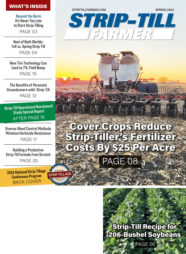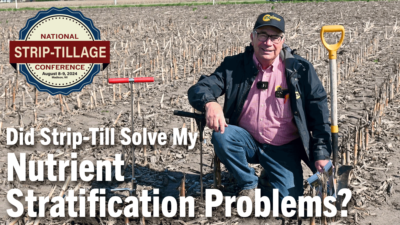John Hanson switched to strip-till a few years ago to save money on fuel and labor costs and increase the moisture-holding capacity of the soils on his 1,600-acre farm in north central Iowa. He’s found a way to be even more efficient by planting soybeans with his Environmental Tillage Systems (ETS) SoilWarrior on around 700 acres.
“It’s just like when you’re putting fertilizer down, except we’re doing it with soybeans instead,” Hanson says. “We angle the tube back a little bit, let the soil cover it up, and we’re done. It saves a lot of time on fuel. You don’t have to cultivate or anything. It’s just 1 pass. Our soybean yields are as high as 68 bushels per acre on some fields, and our average yields are similar to our neighbors’ yields.”
Spring Strip-Till
Hanson makes 100% of his strips for corn and soybeans in the spring. If the weather cooperates, he makes his strips before the end of March and starts planting corn in early April before soybeans.
“We apply 40 pounds of dry urea and 20 pounds of sulfur while making strips for corn,” Hanson says. “If we needed to, we could plant as soon as 1-2 hours after the sun hits those strips.”
Hanson says one of the keys to spring strip-till is making sure there is good fertilizer-to-soil contact, so that nutrients are buried in the strip. He also meets with ETS experts to make sure his strip-till rig is set up properly before taking the field.
Fall Strip-Till
Upper Sandusky, Ohio, strip-tiller Brad Weaver was also looking to increase his operational efficiency when he switched to strip-till in 2019.
“I wondered why we were paying somebody else to spread our fertilizer, only for us to go back and work it into the soil,” Weaver says. “Why not just do it all in 1 pass? For us, it’s all about efficiency, saving time, and not having to wait for the co-op to show up. With strip-till, we can apply the fertilizer on our own and make sure it’s done the right way.”
“We don’t run as much down pressure in the spring because the strip is already there…”
Weaver strip-tills around 900 acres of corn. He makes strips in the fall while applying phosphorous (P) and potassium (K) at variable rates.
“Then in the spring we come back with some nitrogen (N), AMS and micronutrients just to fluff up the strip, and make the best seed bed possible,” Weaver says. “We don’t run as much down pressure in the spring because the strip is already there. The spring pass is mainly for N, to keep some of the weight off the planter and make the planter pass a little easier.”
As a bonus, fall strip-till also widens Weaver’s planting window in the spring if the weather isn’t cooperating.
“Planting always depends on the weather,” Weaver says. “We might be able to start April 10, or it might be May 10. We’re either going to have a nice, relaxing spring, or by the time May 10 rolls around it’s go, go, go as fast as we can. That’s what I like about making strips in the fall — our P and K is already out there, so we can focus on planting.”







Post a comment
Report Abusive Comment